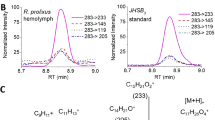Abstract
The potential of analogues of insect juvenile hormones (JHs) for pest control has been demonstrated by the application of methoprene for the selective control of certain insects, including several mosquito species, the cigarette beetle and the hornfly1. Compounds that impede JH production could offer a potentially more attractive method of control because accelerated metamorphosis would shorten the lifetime of the larvae, the stage that usually does maximum damage to the host plant. Of the few anti-juvenile hormone (AJH) agents described2–5, only precocenes evoke all the required biological responses, but they affect a few insect taxa of minor economic importance. Their activity is thought to result from cytotoxicity6,7 in the corpora allata. In view of similarities between the biosynthesis of the carbon skeletons of insect JHs8,9 and farnesyl pyrophosphate (a precursor of steroids and other terpenoids10), compounds that inhibit the early steps in the biosynthesis of cholesterol might be expected to suppress JHs. Although this concept has already been explored without success11,12, we now report the inhibition of juvenile hormone biosynthesis (AJH activity, see Table 1 legend) by a fluorinated mevalonate tetrahydro-4-fluoromethyl-4-hydroxy-2H-pyran-2-one, FMev, Fig. 1) which until now was known only to be hypocholesterolaemic13–15.
This is a preview of subscription content, access via your institution
Access options
Subscribe to this journal
Receive 51 print issues and online access
$199.00 per year
only $3.90 per issue
Buy this article
- Purchase on Springer Link
- Instant access to full article PDF
Prices may be subject to local taxes which are calculated during checkout
Similar content being viewed by others
References
Siddall, J. B. Envir. Hlth Perspectives 14, 119–126 (1976).
Bowers, W. S. in The Juvenile Hormones (ed. Gilbert, L. I.) 394–408 (Plenum, New York, 1976).
Staal, G. B. Scr. varia pont. Sci. 41, 353–383 (1977).
Murakoshi, S. et al. Jap. J. appl. ent. Zool. 19, 267–272 (1975).
Slama, K. Acta ent. bohem. 75, 65–82 (1978).
Brooks, G. T., Pratt, G. E. & Jennings, R. C. Nature 281, 570–572 (1979).
Schooneveld, H. Experientia 35, 363–364 (1979).
Schooley, D. A., Judy, K. J., Bergot, B. J., Hall, M. S. & Jennings, R. C. in The Juvenile Hormones (ed. Gilbert, L. I.) 101–117 (Plenum, New York, 1976).
Law, J. H. in Polyisoprenoid Biosynthesis (ed. Porter, J.) (in the press).
Richards, J. H. & Hendrickson, J. B. The Biosynthesis of Steroids, Terpenes, and Acetogenins (Benjamin, New York, 1964).
Matolcsy, G., Varjas, L. & Bordas, B. Acta phytopath. hung. 10, 455–463 (1975).
Hammock, B. D. et al. J. agric. Fd Chem. 26, 166–170 (1978).
Singer, F. M., Januszka, J. P. & Borman, A. Proc. Soc. exp. Biol. Med. 102, 370–373 (1959).
Tschesche, R., Machleidt, H. & Bucher, T. US Patent 3,075,997, Jan. 29 (1963).
Tschesche, R. & Machleidt, H. Justus Liebigs Annln Chem. 631, 61–76 (1960).
Safranek, L. & Riddiford, L. M. J. Insect Physiol. 21, 1931–1938 (1975).
Staal, G. B. Scr. varia pont. Acad. Sci. 41, 333–352 (1977).
Author information
Authors and Affiliations
Rights and permissions
About this article
Cite this article
Quistad, G., Cerf, D., Schooley, D. et al. Fluoromevalonate acts as an inhibitor of insect juvenile hormone biosynthesis. Nature 289, 176–177 (1981). https://doi.org/10.1038/289176a0
Received:
Accepted:
Issue Date:
DOI: https://doi.org/10.1038/289176a0
This article is cited by
-
10.1007/BF00300901
CrossRef Listing of Deleted DOIs (2011)
-
Juvenilizing effect of ecdysone mimic RH 5849 inGalleria mellonella larvae
Experientia (1992)
-
Cantharidin biosynthesis in a blister beetle: Inhibition by 6-fluoromevalonate causes chemical disarmament
Experientia (1986)
Comments
By submitting a comment you agree to abide by our Terms and Community Guidelines. If you find something abusive or that does not comply with our terms or guidelines please flag it as inappropriate.



